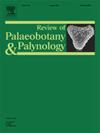Seeds Alapaja (Cupressaceae) from the Cretaceous of Western Siberia and their paleo-DNA
IF 1.7
3区 地球科学
Q2 PALEONTOLOGY
引用次数: 0
Abstract
The article presents the results of cytoembryological research of the structure of fossil seeds in coniferous plants Alapaja cf. uralensis (Cupressaceae) from the Cenomanian–Turonian deposits of Western Siberia (age about 91.5 ± 8.5 Mya), and the results of the Feulgen test for the preservation of their structures' paleo-DNA in the nuclei. The study revealed the presence of fragments of embryo, megagametophyte and nucellus in the seed. The presence of megaspore membrane was also identified in the seed. The seed coat is 2–3-layered, the upper layer is very thin and presents just partially, and the middle layer of testa is represented by sclerotesta, the lower layer cells are fused into a single mass. It was established that nuclei are present in the cells of the embryo, megagametophyte and nucellus, however, in most cases, the DNA-deoxyribose skeleton, serving as a target for the Schiff reagent during the Feulgen reaction, is not cytologically detected in the nuclear chromatin. Only in two cases: in fragments of presumably embryonic tissue and megagametophyte, nuclei with a positive reaction according to Felgen were found, which indicates the preservation of aldehyde groups of deoxyribose in the nuclei of its individual parts.
西西伯利亚西部白垩纪的Alapaja(濯缨草科)种子及其古DNA
文章介绍了对西西伯利亚西冕-土伦沉积(年龄约 91.5 ± 8.5 Mya)中针叶植物 Alapaja cf. uralensis(冲天香科)化石种子结构进行细胞胚胎学研究的结果,以及对种子核中保存的古 DNA 结构进行费尔根检验的结果。研究发现,种子中存在胚、巨孢子体和核仁的碎片。种子中还发现了巨孢子膜。种皮有 2-3 层,上层很薄,只呈现出一部分,种皮的中层由硬核代表,下层细胞融合成一个整体。已确定胚、巨型叶和核细胞中都有细胞核,但在大多数情况下,核染色质中并不能从细胞学角度检测到作为费尔根反应中希夫试剂靶标的脱氧核糖骨架。只有在两种情况下:在推测为胚胎组织的碎片和巨型植物体中,发现了根据费尔根反应呈阳性反应的细胞核,这表明脱氧核糖的醛基团保留在其各个部分的细胞核中。
本文章由计算机程序翻译,如有差异,请以英文原文为准。
求助全文
约1分钟内获得全文
求助全文
来源期刊
CiteScore
3.50
自引率
21.10%
发文量
149
审稿时长
6 months
期刊介绍:
The Review of Palaeobotany and Palynology is an international journal for articles in all fields of palaeobotany and palynology dealing with all groups, ranging from marine palynomorphs to higher land plants. Original contributions and comprehensive review papers should appeal to an international audience. Typical topics include but are not restricted to systematics, evolution, palaeobiology, palaeoecology, biostratigraphy, biochronology, palaeoclimatology, paleogeography, taphonomy, palaeoenvironmental reconstructions, vegetation history, and practical applications of palaeobotany and palynology, e.g. in coal and petroleum geology and archaeology. The journal especially encourages the publication of articles in which palaeobotany and palynology are applied for solving fundamental geological and biological problems as well as innovative and interdisciplinary approaches.

 求助内容:
求助内容: 应助结果提醒方式:
应助结果提醒方式:


